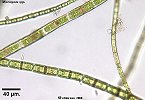![]()
The Genus Microspora
Phylum Chlorophyta; sub-phylum Chlorophyceae; Order Ulotrichales; Family Microsporaceae
Microspora species are unbranched filamentous green algae. There is a single dense net-like chloroplast, usually filling the cell, no pyrenoid. The cells are frequently rather bulbous or barrel-shaped, but the chief diagnostic character is the presence of H-shaped wall sections (only Tribonema shares this characteristic), which can usually be seen in the filament by careful focussing under favourable lighting (condenser iris shut down), and may be most clearly seen at the ends of filaments. When the filament degenerates they are frequently found free. The cell wall may be thin, with the H pieces readily visible overlapping each other slightly, or it may be thick and rather gelatinous in appearance, in which condition it may be diffcult to distinguish from Binuclearia.
Microspora frequently show the presence of darkened, brown bands between adjacent cells.
There are a number of species and mean cell diameter is a guide to species discrimination. Diameters of 8,11, 14, 17, 20 and 22 Ám. are found in acid waters. They are most frequently found tangled in moss or other vegetation, although they initially attach to the substrate by means of a single holdfast cell following settlement of the motile zoospore.
ILLUSTRATIONS: mainly from cultures

This sample from a Midlothian stream contains a range
of sizes of Microspora.

This filament is attached to a microscope slide, along
with other algae.
![]()
John Kinross